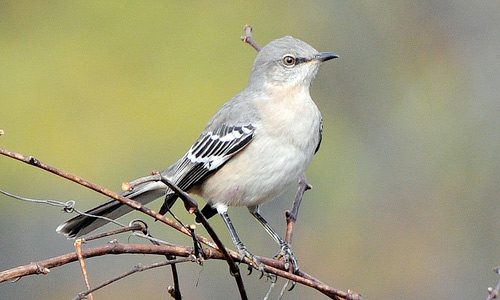AOU Friday: Learning How Birds Learn
By Colleen McLinn, Cornell Lab Education
August 15, 2009

I spent this morning at Erich Jarvis’s keynote address on bird brains and song learning. I had never seen him speak before, but after watching him in a NOVA special I was convinced he is perhaps the Ben Franklin for the neurobiology generation: a renaissance person engaged in truly interdisciplinary work comparing song learning in birds to speech in humans.
Jarvis’s talk kicked off an intense but fascinating morning session called “Communication in Birds and Brains.” Jarvis, a neurobiologist at Duke University, is interested in how the brain controls complex behavior, and noted that bird song is one of the best-studied nonhuman animal behaviors. He particularly seeks to understand how various brain regions control behavioral traits, as well as the evolutionary history of those brain regions.
But first, he had to define vocal learning and explain how it differs from auditory learning, which is rather more widespread among animals. Many species make sounds such as barks or buzzes, and use them to do things like find mates or defend territories. This auditory learning involves comprehension and usage—abilities most animals have, including dogs that can learn simple commands such as “give it here.”
But few animals, and only three groups of birds, have the capability for vocal learning. These include the parrots (natch), the songbirds, and the hummingbirds (a surprising recent discovery). Five groups of mammals are now thought to be vocal learners: humans, whales and other cetaceans, bats, and perhaps elephants and sea lions.
Jarvis is interested in this rarer trait: how and why vocal learning happens, and how it evolved.
Vocal learners mimic sounds they hear, and then modify them to create new sounds. This may not be as much mindless parroting as we used to think—and here Jarvis singled out Irene Pepperberg in the audience, whose experiments with Alex the African Grey Parrot showed that he understood the semantics of a question like “How many total?” well enough to count and reciprocally communicate to Irene that two beads and four beads made “six.”
As for how vocal learning happens, Jarvis and colleagues reported in a staggering series of publications that while all birds use parts of the brain stem to produce songs, those with learned songs also use parts of the forebrain. Birds that learn their songs may even have more than one pathway controlling their learning. One pathway may promote variability in songs while another pathway produces more consistency, or stereotyping. The proper balance between the two pathways allows for vocal learning.
As perhaps a piece of anatomical support for this idea, it appears that birds that learn their songs activate seven specific brain nuclei as they vocalize: three in a forebrain pathway related to mimicry and four in a brain-stem pathway related to sound production.
Jarvis basically threw out the window the received wisdom that humans’ large brain size and extensive brain folding are the explanation for our complex language. When he and colleagues described in 2005 how bird song and human speech actually make use of the same three forebrain regions, it made a splash. People reportedly called Webster’s and asked them to remove the term “bird brain” from the dictionary.
An accidental discovery in 2008 led Jarvis to propose a new idea about vocal learning that involves, of all things, motor coordination. He was comparing the brains of migratory and nonmigratory birds as part of a separate project. To his surprise he found that when the birds flapped, the movement stimulated brain regions next to the areas responsible for song learning.
After another series of experiments, Jarvis found that movement activates seven specific brain regions—but only in vocal learners. It appears that a mutation has caused a connection between motor learning pathways and vocal pathways in these birds. Jarvis believes this kind of mutation—a kind of chance connection between two pre-existing neural pathways—provides an elegant and plausible answer to why a handful of different species have independently evolved vocal learning.
Jarvis ended by discussing the case of Snowball the dancing cockatoo, as a test for his motor theory of vocal learning. If motor learning pathways have indeed been modified to be used in vocal learning, you might expect that vocal learners would have a better sense of rhythm and be better able to synchronize their motions to a musical beat than nonvocal learners. This is indeed the case when we compare Snowball’s moves to those of some other bird species (and even to some humans). From babbling babies to feathered versions of the Backstreet Boys, the neurobiology of imitation and vocal learning is weirder and wilder than I ever knew.


All About Birds is a free resource
Available for everyone,
funded by donors like you






